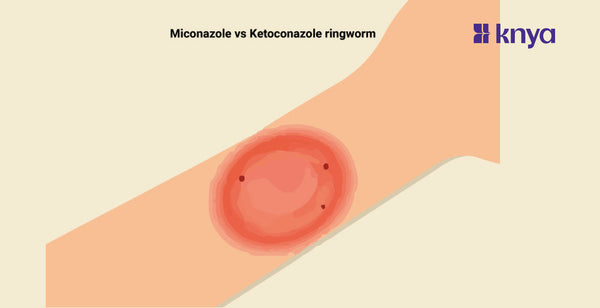Difference between Miconazole vs Ketoconazole for Ringworm: Miconazole and Ketoconazole are both antifungal medicines commonly used to deal with ringworm infections. Miconazole frequently targets dermatophytes, yeast, and some moulds, even as Ketoconazole has a slightly broader spectrum of pastime. Miconazole is to be had in various topical formulations, while Ketoconazole may be located in creams, shampoos, and oral tablets. Both medicines can cause side outcomes together with pores and skin irritation, even though systemic use of Ketoconazole may additionally pose additional dangers. The preference between them depends on factors like contamination severity, place, and patient preferences, warranting consultation with a healthcare professional for personalised treatment steering.
Difference between Miconazole and Ketoconazole
Miconazole primarily targets dermatophytes, while Ketoconazole has a broader spectrum. The table below provides the differences between Miconazole and Ketoconazole ringworm.
|
Feature |
Miconazole |
Ketoconazole |
|
Targeted Fungi |
Primarily dermatophytes |
Broad spectrum (includes yeast) |
|
Formulations Available |
Creams, ointments, powders, sprays, vaginal suppositories |
Creams, shampoos, oral tablets |
|
Over-the-Counter |
Available for mild cases |
Some formulations available |
|
Potential Side Effects |
Skin irritation |
Skin irritation, potential systemic effects with oral tablets |
|
Prescription Requirement |
Generally not required |
Oral tablets may require a prescription |
|
Usage |
Topical application |
Topical or oral administration |
|
Consultation |
Consultation recommended for severe or recurrent cases |
Consultation advised for proper diagnosis and treatment recommendations |
Browse The Best Scrubs Collection!
What is Miconazole?
Miconazole treats fungal infections like ringworm, athlete's foot, jock itch, and yeast infections. It stops fungi from growing and gets rid of the infection. You can buy Miconazole in different forms such as creams, ointments, powders, sprays, and vaginal suppositories without a prescription for mild infections. The medication works by stopping fungi from spreading so the infection goes away.
Features of Miconazole
- Antifungal Properties: Miconazole is effective against various fungal infections, which include ringworm, athlete's foot, jock itch, and vaginal yeast infections.
- Broad Spectrum: It targets fungi, including dermatophytes, yeast, and some moulds.
- Multiple Formulations: Miconazole is available in various formulations such as creams, ointments, powders, sprays, and vaginal suppositories.
- Over-the-Counter Availability: Many Miconazole products are available without a prescription, which allows self-treatment.
What is Ketoconazole?
Ketoconazole is an antifungal medicinal drug normally used to treat ringworm, which is a fungal infection of the pores and skin. It works by inhibiting the boom of fungi responsible for inflicting ringworm, mainly dermatophytes. Ketoconazole is available in numerous formulations, consisting of creams, shampoos, and oral drugs. Topical Ketoconazole creams and shampoos are often used to deal with slight to mild instances of ringworm affecting the skin or scalp, at the same time as oral Ketoconazole pills may be prescribed for excessive or considerable infections. It's crucial to comply with the prescribed remedy routine and seek advice from a healthcare professional for proper diagnosis and control of ringworm infections.
Features of Ketoconazole
- Antifungal Properties: Ketoconazole is primarily designed to target and eliminate fungal infections, including ringworm.
- Broad Spectrum: It is effective against fungi, including dermatophytes, yeast, and moulds, making it suitable for various types of ringworm infections.
- Multiple Formulations: Ketoconazole is available in different formulations, including creams, shampoos, and oral tablets, allowing a wide range of options to choose from.
- Topical and Oral Administration: Ketoconazole is usually applied to the affected area using cream or shampoo if the infection is localised. In case of severe cases such as ringworms, tablets are used.
Shop Best Lab Coats From Here!
Similarities between Miconazole and Ketoconazole
Miconazole and Ketoconazole are antifungal medicines and are commonly used to treat ringworm infections. They share similarities in their broad-spectrum activity against various fungi, multiple available formulations for topical application, over-the-counter availability for mild cases, and generally regarded safety and efficacy. Miconazole and Ketoconazole both offer over-the-counter options for treating mild ringworm infections. They are usually considered to be safe and effective.
Order the Best Jogger Scrub From Here!
| Check out More Articles | |
| Difference Between Cartilage and Bone | |
| Difference Between Endocrine and Exocrine Glands | |
| Difference Between Cell Wall and Cell Membrane | |















